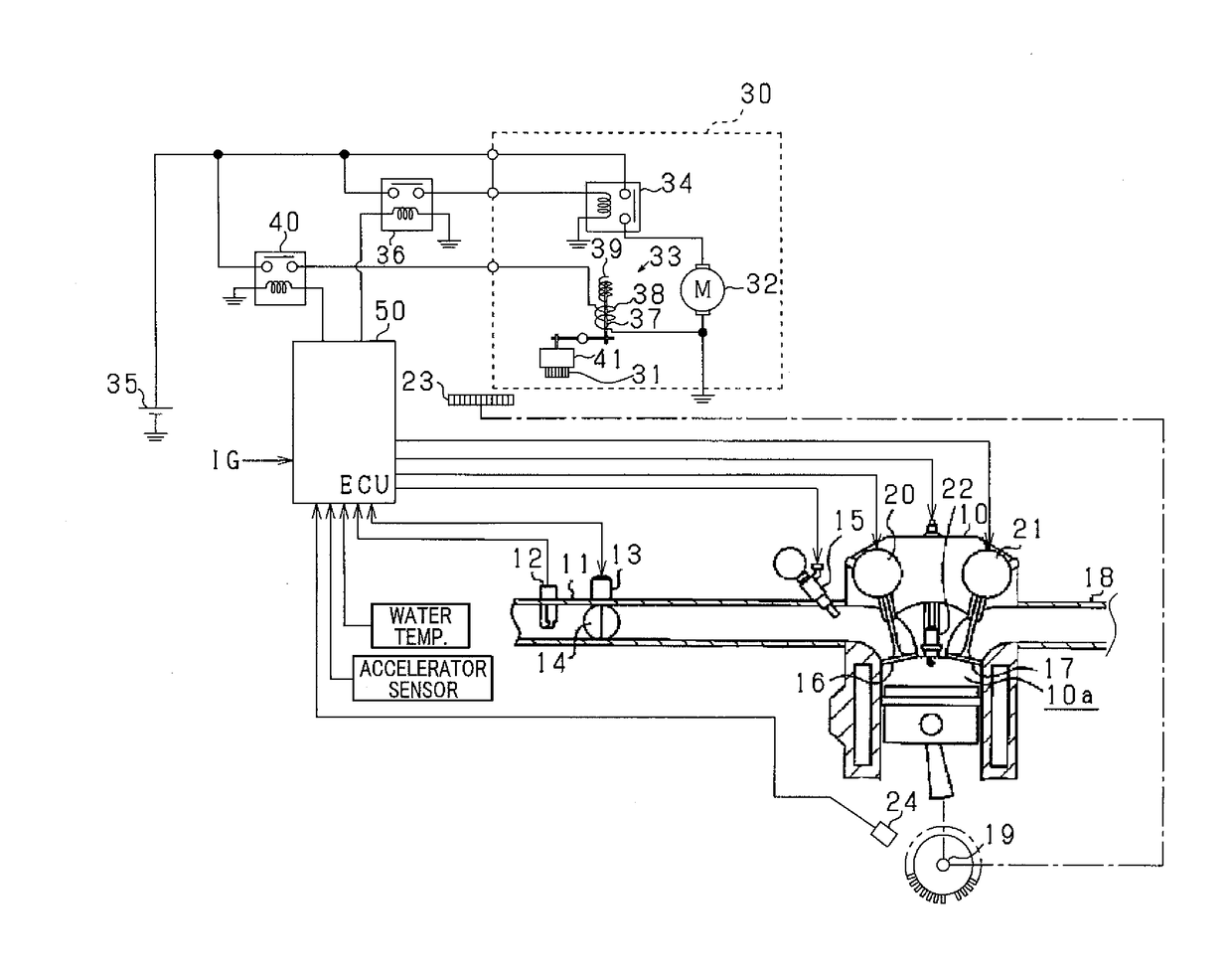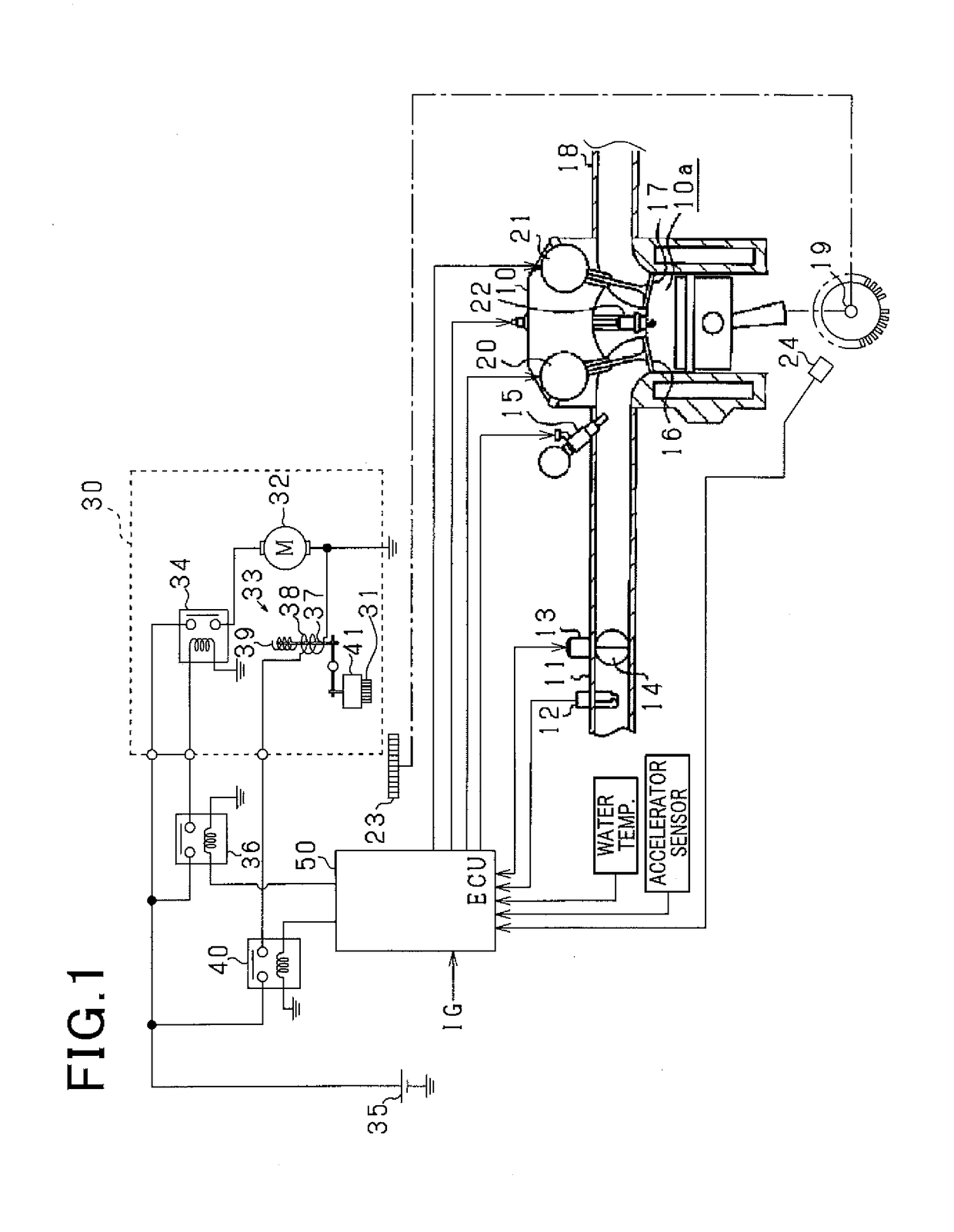Engine control apparatus
- Summary
- Abstract
- Description
- Claims
- Application Information
AI Technical Summary
Benefits of technology
Problems solved by technology
Method used
Image
Examples
first embodiment
[0048]The first embodiment in which an engine control apparatus is used with a vehicle, such as an automobile, equipped with a multi-cylinder four-cycle engine (e.g., a four-cylinder four-cycle engine) working as a main power source will be described below with reference to the drawings.
[0049]The vehicle is, as illustrated in FIG. 1, equipped with an engine 10, a starter 30 (which will also be referred to below as an engine starter), and an ECU (Electronic Control Unit) 50 working as the engine control apparatus. The engine 10 in this embodiment is a spark-ignited gasoline internal combustion engine. The engine 10 has an intake passage 11 in which an air flow meter 12 is installed. The air flow meter 12 works as an intake airflow sensor to measure the amount of intake air per unit time. The intake passage 11 has also installed therein a throttle valve 14 which is located downstream of the air flow meter 12 and driven by a throttle actuator 13 to regulate an area of a flow path in th...
second embodiment
[0080]The second embodiment will be described below with respect to differences between itself and the first embodiment. The ECU 50 of this embodiment is designed to change, that is, determine the cranking terminating time as a function of the pulsating component contained in the speed of the engine 10 instead of the air intake quantity Gr.
[0081]FIG. 7 is a flowchart of a sequence of logical steps in a start control program executed by the ECU 50 in the second embodiment. The same step numbers, as employed in FIG. 2, will refer to the same operations, and explanation thereof in detail will be omitted here.
[0082]After step S14 wherein the starter 30 is turned on, the routine proceeds to step S22 wherein an amplitude ΔN of the pulsating component contained in the engine speed NE is calculated. The amplitude ΔN of the pulsating component may be, as can be seen in FIG. 6(a), derived by a difference between a minimum value N1 and a maximum value N2 of the engine speed NE while the engine...
third embodiment
[0085]The third embodiment will be described below with respect to differences between itself and the first embodiment. The ECU 50 of this embodiment is designed to deactivate the starter 30 to terminate the cranking operation after the air-fuel mixture has been ignited in the combustion chamber 10a when the pulsating component contained in the speed of the engine 10 is great.
[0086]FIG. 8 is a flowchart of a sequence of logical steps in a start control program executed by the ECU 50 in the third embodiment. The same step numbers, as employed in FIG. 2, will refer to the same operations, and explanation thereof in detail will be omitted here.
[0087]After step S14 wherein the starter 30 is turned on, the routine proceeds to step S24 wherein it is determined whether the engine speed NE is higher than or equal to the intermediate speed Nmin, as already explained in the first embodiment. The ECU 50 works as a sub-determiner to execute the operation in step S24. The intermediate speed Nmin...
PUM
 Login to View More
Login to View More Abstract
Description
Claims
Application Information
 Login to View More
Login to View More - R&D
- Intellectual Property
- Life Sciences
- Materials
- Tech Scout
- Unparalleled Data Quality
- Higher Quality Content
- 60% Fewer Hallucinations
Browse by: Latest US Patents, China's latest patents, Technical Efficacy Thesaurus, Application Domain, Technology Topic, Popular Technical Reports.
© 2025 PatSnap. All rights reserved.Legal|Privacy policy|Modern Slavery Act Transparency Statement|Sitemap|About US| Contact US: help@patsnap.com



